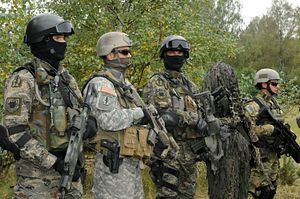Where did U.S. special operations forces come from? The answer, as with any major organizational entity, is complicated. The general want for special forces stems from a desire to concentrate and leverage high human capital- both in training and selection- for the accomplishment of specific, extremely difficult military tasks.
But as discussed in Mark Moyar’s new book, Oppose Any Foe, U.S. special operations emerged through a complicated process of inter- and intra-organizational dispute, waged over the course of several decades. Indeed, Moyar’s account makes clear that much of the history of the development of U.S. special operations forces is the story of their use in East Asia. Many of the foundations of modern special operations forces were laid in the Asia, whether in the Pacific theater or China theaters of World War II, or in the mountains of Korea, or the jungles of Vietnam.
In the early days of the Pacific War, the Marine Corps and the Army developed teams of what would come to be known as special forces to raid Japanese held islands. The strategic intent was to create a sense of vulnerability; Japan could only selectively defend the vast territories that it had conquered, and raids against specific islands could force the Japanese to overcommit. These raids largely succeeded from a tactical point of view, although only at significant cost; there’s not much indication that they changed Japanese strategic decision-making, however. In Burma, “Merrill’s Marauders,” a unit assembled largely from U.S. Army infantry volunteers and intended for raiding, instead found itself committed to conventional combat in setpiece battles against Japanese forces. It suffered devastating losses over the course of the 1944 Burma campaign, losing four-fifths of its total strength.
The interest in special operations forces waned in the last year of World War II, and the subject received little attention until the start of the Korean War, when irregular units of the Korean People’s Army began to wreak havoc behind UN lines. The U.S. Army created units similar to those that had operated in World War II, although with relatively little success; most of the units found themselves in regular, conventional combat.
By the time of the Vietnam War, special forces had begun to take something approaching their modern shape. The responsibilities of SOF shifted from inciting rebellions to tamping them down. Assisted in large part by the development of effective helicopter transport, special forces could deploy and raid in a variety of different circumstances. They could also have an outsized impact on the relatively low number of conventional infantry battles fought during the war. Tensions between the special operations community and the regular services flared across the war, but the outlines of a niche had begun to show.
The full flowering of special operations forces wouldn’t come until after Vietnam; such units demonstrated flare and capability in counter-terror missions, even before the onset of the so-called “war on terror” during the George W. Bush years. Iran, Grenada, Somalia, and eventually Afghanistan were the cauldrons in which the United States forged what has now become a formidable SOF capability. Nevertheless, the seeds for this were sown in a series of wars in East Asia, in which conventional U.S. forces faced unconventional, unexpected threats.

































